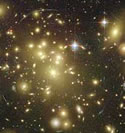
Image credit: Hubble
The Hubble Space Telescope has used a natural 2-million-light-year wide “zoom lens” to look further into space than it normally could. By peering directly through the centre of one of the most massive galactic clusters known, it was able to take advantage of a technique called gravitational lensing to see objects beyond the cluster. Detailed analysis of the image may help shed some light on the mystery of dark matter.
The Advanced Camera for Surveys aboard NASA’s Hubble Space Telescope has used a natural “zoom lens” in space to boost its view of the distant universe. Besides offering an unprecedented and dramatic new view of the cosmos, the results promise to shed light on galaxy evolution and dark matter in space.
Hubble peered straight through the center of one of the most massive galaxy clusters known, called Abell 1689. This required that Hubble gaze at the distant cluster, located 2.2 billion light-years away, for over 13 hours. The gravity of the cluster’s trillion stars ? plus dark matter ? acts as a 2-million-light-year-wide “lens” in space. This “gravitational lens” bends and magnifies the light of galaxies located far behind it.
The Advanced Camera’s IMAX movie-quality sharpness, combined with the behemoth lens, reveals remote galaxies previously beyond even Hubble’s reach. A few may be twice as faint as those photographed in the Hubble Deep Field, which previously pushed the telescope to its sensitivity limits. Though much more analysis is needed, Hubble astronomers speculate that some of the faintest objects in the picture are probably over 13 billion light-years away (redshift value 6).
In the image hundreds of galaxies many billions of light-years away are smeared by the gravitational bending of light into a spider-web tracing of blue and red arcs of light. Though gravitational lensing has been studied previously with Hubble and ground-based telescopes, this phenomenon has never been seen before in such detail. The ACS picture reveals 10 times more arcs than would be seen by a ground-based telescope. The ACS is 5 times more sensitive and provides pictures that are twice as sharp as the previous work-horse Hubble cameras. So it can see the very faintest arcs with greater clarity. The picture presents an immense jigsaw puzzle for Hubble astronomers to spend months untangling. Interspersed with the foreground cluster are thousands of galaxies, which are lensed images of the galaxies in the background universe.
Detailed analysis of the images promises to shed light on the mystery of dark matter. Dark matter is an invisible form of matter. It is the source of most of the gravity in the universe because it is much more abundant than the “normal matter” that makes up planets, stars and galaxies. The lensing allows astronomers to map the distribution of dark matter in galaxy clusters. This should offer new clues to the nature of dark matter. By studying the lensed distant galaxies, astronomers expect to better trace the history of star formation in the universe, over the past 13 billion years.
The picture is an exquisite demonstration of Albert Einstein’s prediction that gravity warps space and therefore distorts a beam of light, like a rippled shower curtain. Though Einstein realized this effect would happen in space, he thought it could never be observed from Earth. Though individual stars lens background light, the deflection was too small to ever be seen from Earth. When the laws of relativity were formulated in the early 20th century, scientists did not know that stars were organized into galaxies beyond our own Milky Way. Great clusters of galaxies are massive enough to warp space and deflect light in a way that is detectable from Earth. The Abell cluster is the ideal target because it is so massive. The more massive a cluster, the larger the effects of gravitational lensing.
Original Source: Hubble News Release

Since the ancestral time, world space research is progressing on wrong concept because we unknown about space mirror which is a great mystery and creator of lots of mysteries viz. milk ways, galaxies, nebulas, white duffs, black holes etcs. Hence without study of space mirror the space research has no future.
In sort it can not explain in short. Therefore it invites to visit http://www.spacemirrormystery.com to know the original truth
Mirror reflects frontier. Mirror functions like a wall. There is nothing ahead of mirror but reflection makes lively atmosphere into mirror. If two mirrors face each other in parallel position the concerned area between mirrors is converted to a biggest atmosphere because the concerned area reflected unlimitedly as front side and backside into each mirror frequently. Space mirror is based on above rule and we are unknown about space mirror.
From sun the objects of area 225 million kilometer to 300 million kilometer of solar system reflects unlimitedly, we find a very deep space and through giant telescopes we watch mystery after mystery.
Telescope enlarges view not closes near view. Following may clear the concept.
“A visitor of a desert often find mirage. If he moves, mirage also moves. He can never reach near the mirage. If he tries he can see enlarge view of mirage as smoky atmosphere through a telescopic instrumentâ€.
Giant telescope like Hubble and others may be the milestone of our technology but it can not help the real space research.